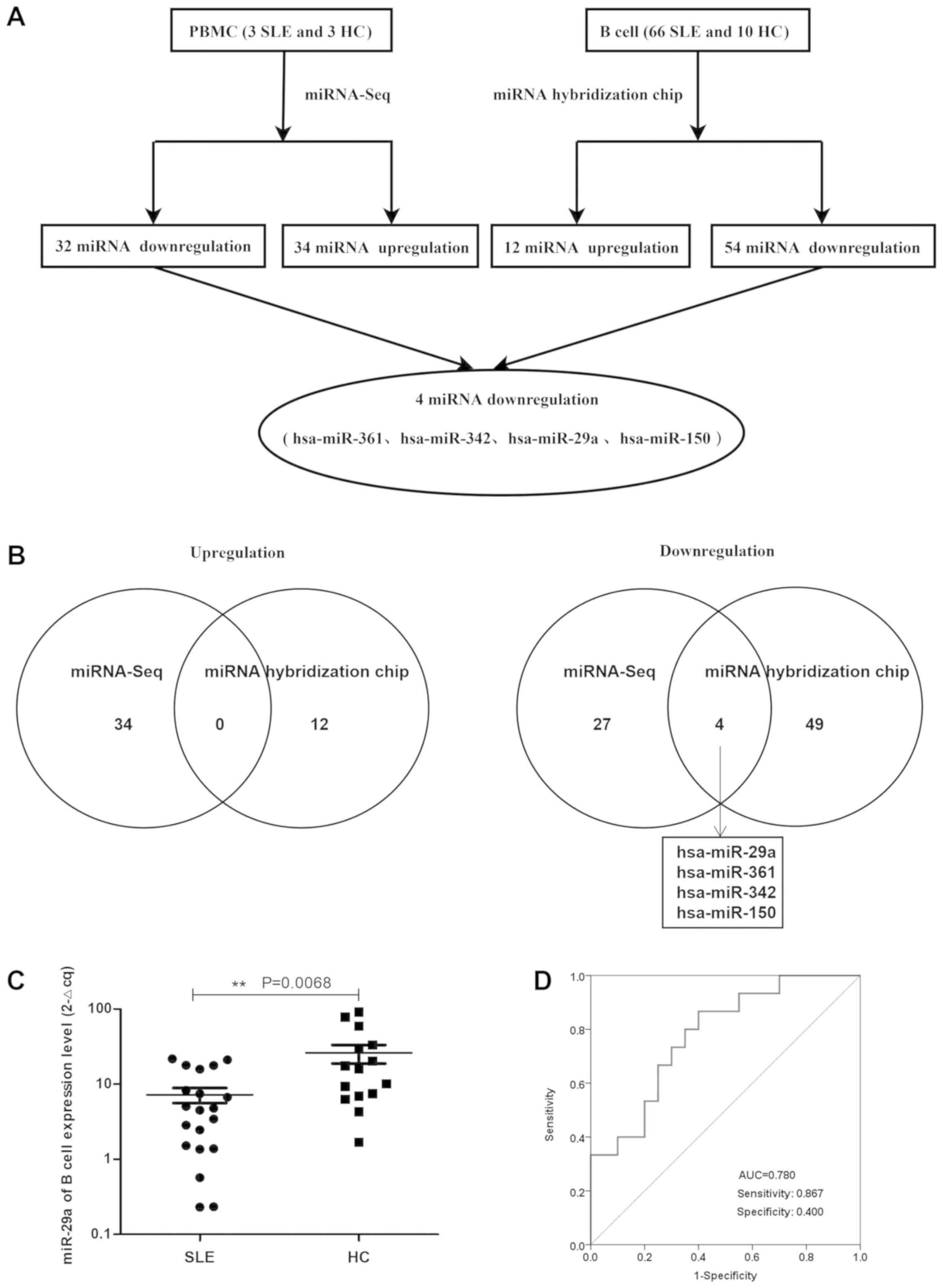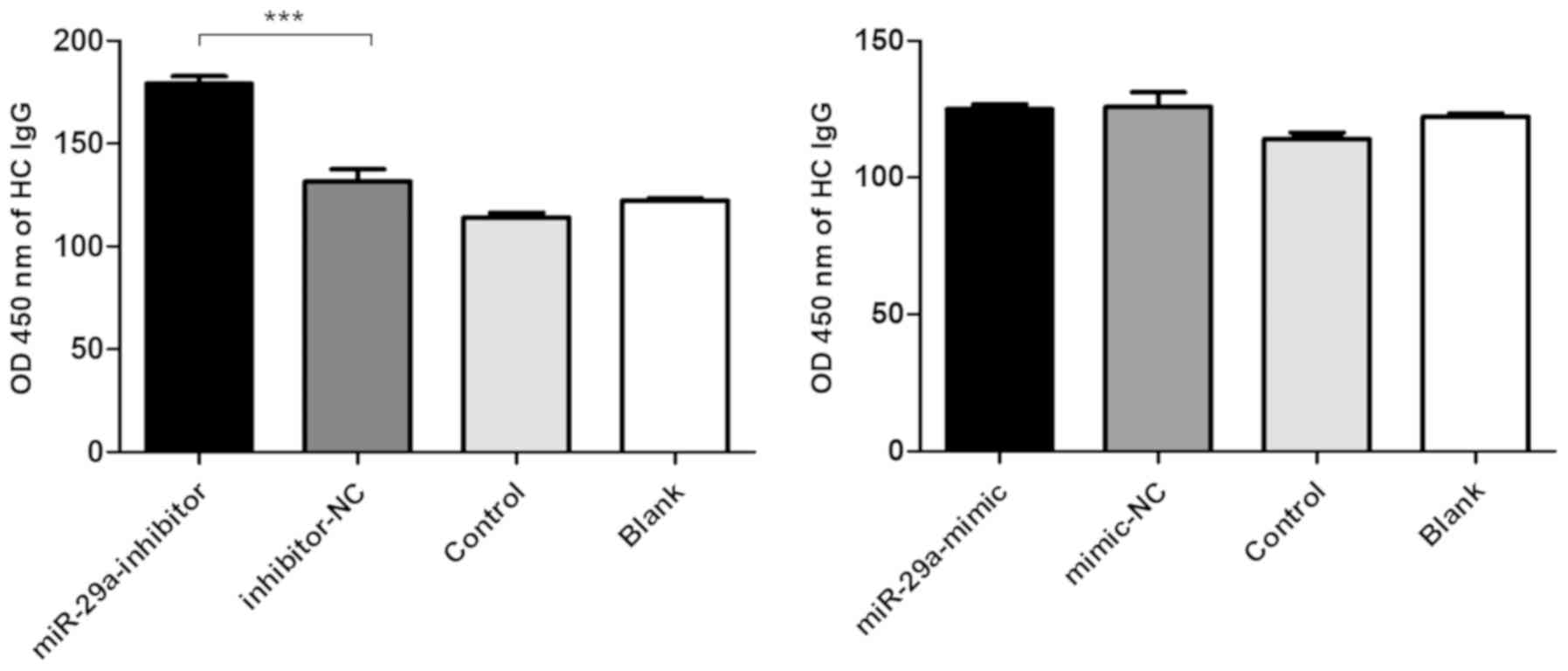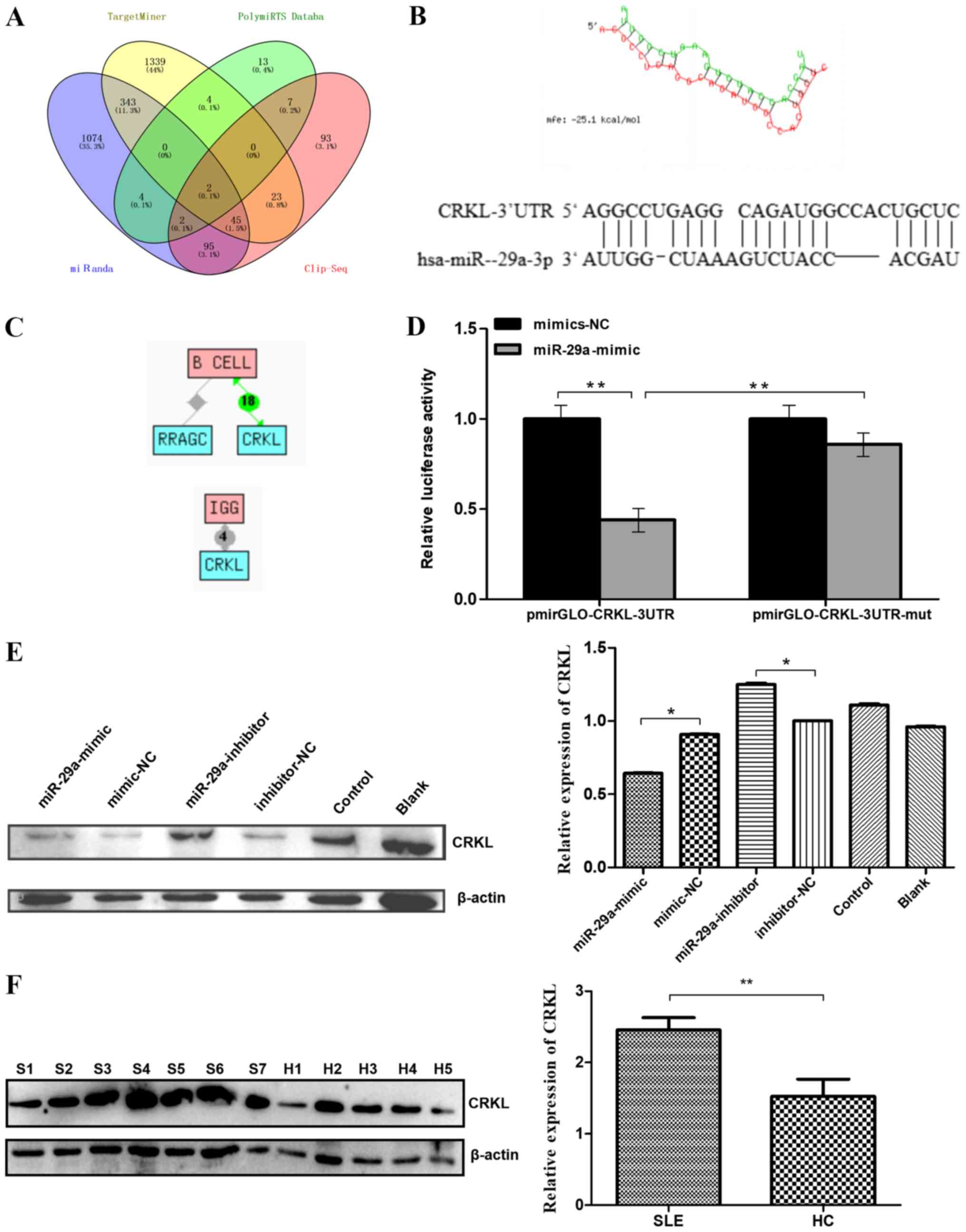|
1
|
Frieri M: Mechanisms of disease for the
clinician: Systemic lupus erythematosus. Ann Allerg Asthma Im.
110:228–232. 2013. View Article : Google Scholar
|
|
2
|
Ziegelasch M, van Delft MA, Wallin P,
Skogh T, Magro-Checa C, Steup-Beekman GM, Trouw LA, Kastbom A and
Sjöwall C: Antibodies against carbamylated proteins and cyclic
citrullinated peptides in systemic lupus erythematosus: Results
from two well-defined European cohorts. Arthritis Res Ther.
18:2892016. View Article : Google Scholar : PubMed/NCBI
|
|
3
|
Guo G, Wang H, Shi X, Ye L, Wu K, Lin K,
Ye S, Li B, Zhang H, Lin Q, et al: NovelmiRNA-25 inhibits AMPD2 in
peripheral blood mononuclear cells of patients with systemic lupus
erythematosus and represents a promising novel biomarker. J Transl
Med. 16:3702018. View Article : Google Scholar : PubMed/NCBI
|
|
4
|
Jeltsch-David H and Muller S:
Neuropsychiatric systemic lupus erythematosus: Pathogenesis and
biomarkers. Nat Rev Neurol. 10:579–596. 2014. View Article : Google Scholar : PubMed/NCBI
|
|
5
|
Bernatsky S, Joseph L, Boivin JF, Gordon
C, Urowitz M, Gladman D, Fortin PR, Ginzler E, Bae SC, Barr S, et
al: The relationship between cancer and medication exposures in
systemic lupus erythaematosus: A case-cohort study. Ann Rheum Dis.
67:74–79. 2008. View Article : Google Scholar : PubMed/NCBI
|
|
6
|
Baudino L, Yoshinobu K, Morito N,
Santiago-Raber ML and Izui S: Role of endogenous retroviruses in
murine SLE. Autoimmun Rev. 10:27–34. 2010. View Article : Google Scholar : PubMed/NCBI
|
|
7
|
Luo S, Liu Y, Liang G, Zhao M, Wu H, Liang
Y, Qiu X, Tan Y, Dai Y, Yung S, et al: The role of microRNA-1246 in
the regulation of B cell activation and the pathogenesis of
systemic lupus erythematosus. Clin Epigenetics. 7:242015.
View Article : Google Scholar : PubMed/NCBI
|
|
8
|
Yu F, Haas M, Glassock R and Zhao MH:
Redefining lupus nephritis: Clinical implications of
pathophysiologic subtypes. Nat Rev Nephrol. 13:483–495. 2017.
View Article : Google Scholar : PubMed/NCBI
|
|
9
|
Xie HH, Shen H, Zhang L, Cui MY, Xia LP
and Lu J: Elevated serum interleukin-34 level in patients with
systemic lupus erythematosus is associated with disease activity.
Sci Rep. 8:34622018. View Article : Google Scholar : PubMed/NCBI
|
|
10
|
Zhou B, Zuo XX, Li YS, Gao SM, Dai XD, Zhu
HL and Luo H: Integration of microRNA and mRNA expression profiles
in the skin of systemic sclerosis patients. Sci Rep. 7:428992017.
View Article : Google Scholar : PubMed/NCBI
|
|
11
|
Luo Q, Liu J, Fu B, Zhang L, Guo Y, Huang
Z and Li J: Circular RNAs Hsa_circ_0002715 and Hsa_circ_0035197 in
peripheral blood are novel potential biomarkers for new-onset
rheumatoid arthritis. Dis Markers. 2019:20731392019. View Article : Google Scholar : PubMed/NCBI
|
|
12
|
He L and Hannon GJ: MicroRNAs: Small RNAs
with a big role in gene regulation. Nat Rev Genet. 5:522–531. 2004.
View Article : Google Scholar : PubMed/NCBI
|
|
13
|
Xiao C and Rajewsky K: microrna control in
the immune system: Basic principles. Cell. 136:26–36. 2009.
View Article : Google Scholar : PubMed/NCBI
|
|
14
|
Ma X and Liu Q: MicroRNAs in the
pathogenesis of systemic lupus erythematosus. Int J Rheum Dis.
16:115–121. 2013. View Article : Google Scholar : PubMed/NCBI
|
|
15
|
de Yébenes VG, Bartolomé-Izquierdo N and
Ramiro AR: Regulation of B-cell development and function by
microRNAs. Immunol Rev. 253:25–39. 2013. View Article : Google Scholar : PubMed/NCBI
|
|
16
|
Hong Y, Wu J, Zhao J, Wang H, Liu Y, Chen
T, Kan X, Tao Q, Shen X, Yan K and Zhai Z: miR-29b and miR-29c are
involved in Toll-like receptor control of glucocorticoid-induced
apoptosis in human plasmacytoid dendritic cells. PLoS One.
8:e699262013. View Article : Google Scholar : PubMed/NCBI
|
|
17
|
Monteleone K, Selvaggi C, Cacciotti G,
Falasca F, Mezzaroma I, D'Ettorre G, Turriziani O, Vullo V,
Antonelli G and Scagnolari C: MicroRNA-29 family expression and its
relation to antiviral immune response and viro-immunological
markers in HIV-1-infected patients. BMC Infect Dis. 15:512015.
View Article : Google Scholar : PubMed/NCBI
|
|
18
|
Sun XJ, Liu BY, Yan S, Jiang TH, Cheng HQ,
Jiang HS, Jiang HS, Cao Y and Mao AW: MicroRNA-29a promotes
pancreatic cancer growth by inhibiting tristetraprolin. Cell
Physiol Biochem. 37:707–718. 2015. View Article : Google Scholar : PubMed/NCBI
|
|
19
|
Liston A, Papadopoulou AS, Danso-Abeam D
and Dooley J: MicroRNA-29 in the adaptive immune system: Setting
the threshold. Cell Mol Life Sci. 69:3533–3541. 2012. View Article : Google Scholar : PubMed/NCBI
|
|
20
|
Wang X, Zhang C, Wu Z, Chen Y and Shi W:
CircIBTK inhibits DNA demethylation and activation of AKT signaling
pathway via miR-29b in peripheral blood mononuclear cells in
systemic lupus erythematosus. Arthritis Res Ther. 20:1182018.
View Article : Google Scholar : PubMed/NCBI
|
|
21
|
Ahluwalia JK, Khan SZ, Soni K, Rawat P,
Gupta A, Hariharan M, Scaria V, Lalwani M, Pillai B, Mitra D and
Brahmachari SK: Human cellular microRNA hsa-miR-29a interferes with
viral nef protein expression and HIV-1 replication. Retrovirology.
5:1172008. View Article : Google Scholar : PubMed/NCBI
|
|
22
|
Hochberg MC: Updating the American college
of rheumatology revised criteria for the classification of systemic
lupus erythematosus. Arthritis Rheum. 40:17251997. View Article : Google Scholar : PubMed/NCBI
|
|
23
|
Maugeri M, Barbagallo D, Barbagallo C,
Banelli B, Di Mauro S, Purrello F, Magro G, Ragusa M, Di Pietro C,
Romani M and Purrello M: Altered expression of miRNAs and
methylation of their promoters are correlated in neuroblastoma.
Oncotarget. 7:83330–83341. 2016. View Article : Google Scholar : PubMed/NCBI
|
|
24
|
Livak KJ and Schmittgen TD: Analysis of
relative gene expression data using real-time quantitative PCR and
the 2(-Delta Delta C(T)) method. Methods. 25:402–408. 2001.
View Article : Google Scholar : PubMed/NCBI
|
|
25
|
Lipsky PE: Systemic lupus erythematosus:
An autoimmune disease of B cell hyperactivity. Nat Immunol.
2:764–766. 2001. View Article : Google Scholar : PubMed/NCBI
|
|
26
|
Sherer Y, Gorstein A, Fritzler MJ and
Shoenfeld Y: Autoantibody explosion in systemic lupus
erythematosus: More than 100 different antibodies found in SLE
patients. Semin Arthritis Rheum. 34:501–537. 2004. View Article : Google Scholar : PubMed/NCBI
|
|
27
|
Zhao M, Liu Q, Liang G, Wang L, Luo S,
Tang Q, Zhao H, Su Y, Yung S, Chan TM and Lu Q: E4BP4
overexpression: A protective mechanism in CD4+ T cells from SLE
patients. J Autoimmun. 41:152–160. 2013. View Article : Google Scholar : PubMed/NCBI
|
|
28
|
Zhao JJ, Lin J, Lwin T, Yang H, Guo J,
Kong W, Dessureault S, Moscinski LC, Rezania D, Dalton WS, et al:
MicroRNA expression profile and identification of miR-29 as a
prognostic marker and pathogenetic factor by targeting CDK6 in
mantle cell lymphoma. Blood. 115:2630–2639. 2010. View Article : Google Scholar : PubMed/NCBI
|
|
29
|
Liu M, Zeng X, Lu YX, Mo YJ, Liao TH, Gan
C and Lu XQ: Study on molecular mechanism of MiRNA-29a in promoting
proliferation and invasion of non-small-cell lung cancer by
inhibiting MTSS1. Eur Rev Med Pharmacol Sci. 22:5531–5538.
2018.PubMed/NCBI
|
|
30
|
Aiello FB, Guszczynski T, Li W, Hixon JA,
Jiang Q, Hodge DL, Massignan T, Di Lisio C, Merchant A, Procopio
AD, et al: IL-7-induced phosphorylation of the adaptor Crk-like and
other targets. Cell Signal. 47:131–141. 2018. View Article : Google Scholar : PubMed/NCBI
|
|
31
|
Jankowski A, Zhu P and Marshall JG:
Capture of an activated receptor complex from the surface of live
cells by affinity receptor chromatography. Anal Biochem.
380:235–248. 2008. View Article : Google Scholar : PubMed/NCBI
|

















